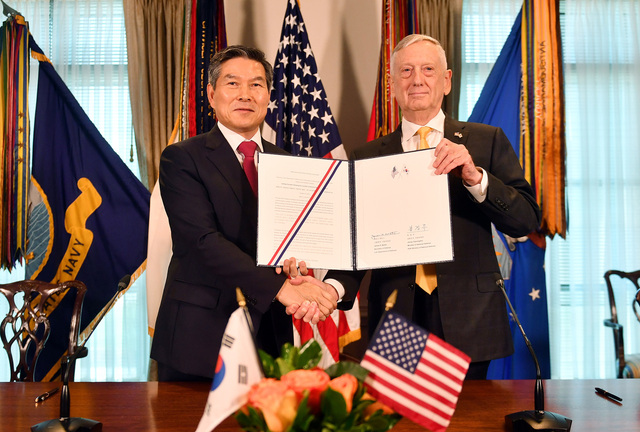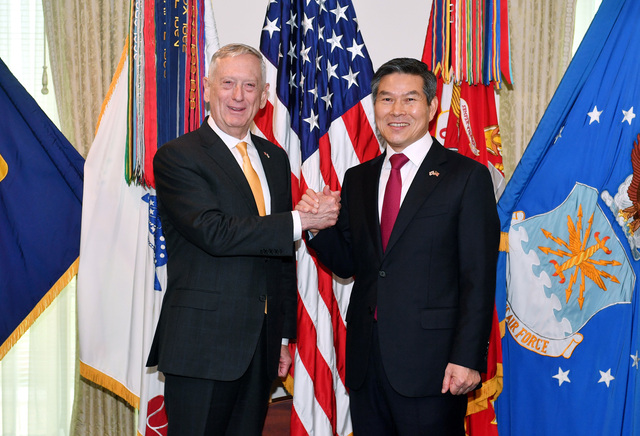 |
|
South Korean Defense Minister Jeong Kyeong-doo and US Secretary of Defense James Mattis pose for a commemorative photograph of the signing of a key document related to the transfer of wartime operational control of South Korean troops, known as OPCON, before a joint press conference following the 50th South Korea-US Security Consultative Meeting on Oct. 31 in Washington, DC. (provided by the Ministry of National Defense)
|
USFK to remain after transfer of wartime operational control of S. Korean troops
During a press conference immediately after the 50th South Korea-US Security Consultative Meeting, which was held in Washington, DC, on Oct. 31, South Korean Defense Minister Jeong Kyeong-doo said that “the foundation for the OPCON transfer has been laid” in regard to his signing an important document related to the transfer of wartime operational control of South Korean troops, known as OPCON. After making these comments in the opening remarks to a joint press conference with US Secretary of Defense James Mattis, Jeong said that “the specific timeframe of the handover will be decided by South Korea and the US.” During the Security Consultative Meeting (SCM) on Wednesday, Jeong and Mattis signed and announced guiding principles for alliance defense that stipulate that US Forces Korea and the UN Command will be maintained even after OPCON has been transferred from the US military to the South Korean military. According to the Alliance Guiding Principles announced by South Korea and the US, “As a symbol of the commitment pursuant to the Mutual Defense Treaty, US Forces Korea (USFK) is to continue to be stationed on the Korean Peninsula and firmly fulfill the security commitment to the ROK.” This is aimed at reassuring concerns expressed in some quarters of South Korea and the US that American troops could be withdrawn during the process of moving toward North Korea’s denuclearization. The guiding principles also said that “The ROK-US post-OPCON transition Combined Forces Command and its subordinate combined component commands are to be established to deter external aggression and, if deterrence fails, to defend the ROK.” This was also the first document to stipulate the new command structure of Combined Forces Command: “The national authorities of the ROK are to appoint a General or an Admiral to serve as the Commander of the post-OPCON transition Combined Forces Command, and the national authorities of the United States are to appoint a General or an Admiral to serve as the deputy commander of the post-OPCON transition Combined Forces Command.” South Korea and the US said that the Alliance Guiding Principles had been adopted “to maintain a reinforced combined defense posture even after the transition of wartime operational control.” During their summit in June 2017, South Korean President Moon Jae-in and US President Donald Trump agreed to move quickly to enable the transfer of OPCON to the South Korean military, as conditions permitted. Prior to that, during the 46th SCM in 2014, South Korea and the US stipulated three conditions for the OPCON transfer. First, the South Korea had to acquire key military capabilities to lead the two countries’ combined defense; second, it had to secure the essential capabilities to make an early response to North Korea’s nuclear and missile threat; and third, the management of the security environment on the Korean Peninsula and in the region had to be conducive to an OPCON transfer. Now that South Korea and the US have signed the Alliance Guiding Principles, they’re expected to accelerate preparations for the OPCON transfer. They agreed that next year they would begin verifying South Korea’s initial operational capacity, or IOC, to lead the future combined command structure, while skipping a preliminary stage of assessment.
 |
|
South Korean Defense Minister Jeong Kyeong-doo and US Secretary of Defense James Mattis shake hands before a joint press conference following the 50th South Korea-US Security Consultative Meeting on Oct. 31 in Washington, DC. (provided by the Ministry of National Defense)
|







